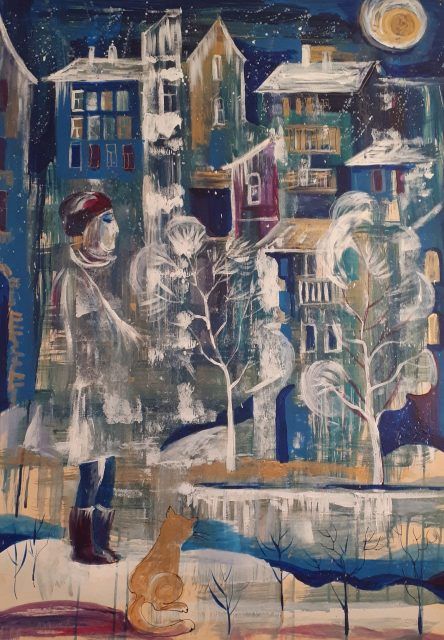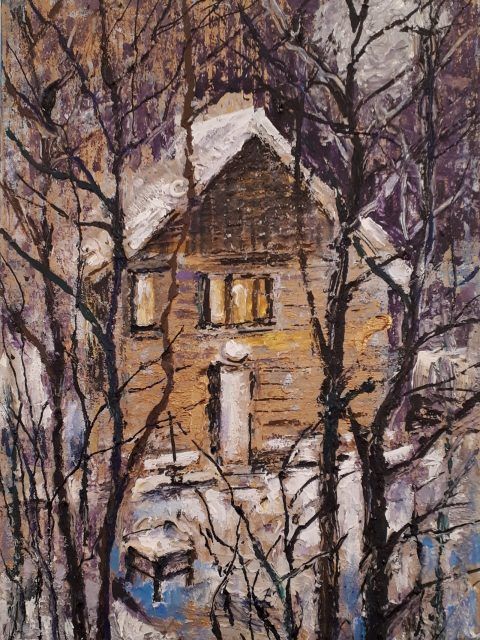Introducing Oxána Bódis, a celebrated local artist and graduate in arts and technical drawing, who is originally from Bobrujszk, a town south-east of Minsk, Belarus. She moved to Hungary in 1990.
Her characteristic paintings range from the use of aquarelles, graphics, oils and so forth, to deliver a captivating repertoire of very fine visuals that consist of landscapes, still life, illustrious fairy-tale scenes and much more.
During her ongoing professional career, Oxána has produced an impressive high calibre of distinguishing works. Over the years there have been various nationwide exhibitions, as well as around Europe showcasing her impressive portfolio. Many of her paintings are real enough at first glance, in a visual and dimensional sense. But when one looks closer, a lot – alongside her frequent depictions of cats – combined with general overviews of twilight and eventual backgrounds, they symbolically become one and the same with real-life and dream-like spheres all round.
Many also touch on a distinctly homely and influential Eastern Slavic aesthetic, which always delivers its own unique blend of illuminating colours and style. This distinct form relates to this artist’s roots and can be often found among her works at an exhibition in the commendable Fári art and antique gallery, at 30 Bártok Béla út in District XI.
But without further ado, these twinkly portrayals are alluring and finally speak for themselves. There is no need for further commentaries from an art amateur such as me. Therefore, welcome Oxána, it was a pleasure to attend the opening of your exhibition.
Please tell me something about your background and how you came to be an artist?
My father was a military officer, my mother was a naturopathic physician. As a child I studied maths and physics. I was also a member of the school theatre group. But I was also most fortunate, as I won various school competitions one after another. All these could have led to careers ranging from journalism to being an actress, as these were also presented to me. But fate finally intervened, as one day some boys from my former neighbourhood saw me drawing from a street side. They told me it would be worthwhile to continue pursuing my artistic skills. Remarkably, with conviction, they literally ushered me to one of the local art schools, which was recruiting then. This is how my lifelong love for the arts began. I graduated as a fine-arts teacher in Minsk, I got married, moved to Hungary and have remained with this profession ever since.

Your styles and techniques are positive, calm and graceful. You clearly have a love for cats and twilight. I also noticed that doctors and medical care staff are very keen to acquire your pictures for the sake of creating more harmonious atmospheres for the patients, and in particular with children. Please tell more about this.
I have some of my pictures in several medical clinics, as I was often told my paintings have special beneficial effects. There was a patient who overcame a serious car accident, simply because he took to one of my pictures, which was at the right place at the right time, and remarkably it provided some form of inner therapy and relief to him. I also receive much feedback from doctors and nurses. It’s also great to know my images deliver calming effects on patients who have blood-pressure complaints. This matter also applies with the cases of children at doctor surgeries and at hospital wards.
Have you worked as a book illustrator? Have you decorated any public spaces?
I have illustrated some books. I very much like fairy-tale imagery. I am working on a book project right now. I also decorated the walls at the “Three Pyjamas” Breakfast Club in Budapest.
Who are your art influences?
Repin and Munkácsy are clearly great painters. Although I appreciate their works, personally I prefer Vincent van Gogh and Amedeo Modigliani. In addition, I have always admired artists whose works have their own identities and can never be mistaken for someone else’s, such as the distinguishable Marc Chagall and Anatoly Zverev.
What is your general artistic philosophy when it comes to working with your students?
I have been teaching for a long time. Nowadays I have a few private students. All my pupils are individuals with different requirements. Therefore I must apply special attention to each in turn. However, the common point, in each case, is I always want to pass on basic knowledge whilst at the same time maintaining their own personalities and skills. I am never afraid to show tricks of the trade and new, compelling techniques. I am always happy to share my knowledge with everyone.
My general philosophy and goals are not only to teach students to paint and draw, but to also allow them to find their own way into any projects with confidence and ease. As well as to touch on and to bring out their own inner artistic ventures and talents onto paper and canvases.
In this way not only do they learn how to – but also what to draw or paint with greater effects and more meaning. After initial encouragement, my students finally find their own way with what they want to achieve in their own works. Tapping into one’s hidden senses in an intuitive way, to deliver new skills, always brings out the best in everyone, and is as important as all else in my profession.

Tell me something about painting Budapest scenery.
You cannot get enough of the beauty of Budapest. First of all, its charm lies in knowing it does not matter how many times I see the same abundances of buildings, as many are unique in their clarity and splendour, and there is always something new to see. There are the highly prized landmarks in the city – like the Fisherman’s Bastion – where time and space is literally abandoned for me every time I am there. On every occasion when there, a surreal artistic feeling always overcomes me – it is simply inexplicable. Other than to say the past, present and future are always one and the same for me when there. I have not touched on this matter for some time, because I am afraid this may appear as an overstatement, as an artistic and temperamental cliché. It’s obvious, the immediate central cityscapes have been drawn, painted, photographed many times over. But on my last visit to this very distinguishing peak, I finally got new artistic inspirations. As I finally felt the urge to deliver on my impressions of this landmark, as well as Central Buda and Pest, regardless of obvious competition.
What’s next with your art journey?
The adventure is always a continual one because we do not always know what will happen next. I hope the future holds new and challenging inspirations, experiences, energies and exciting themes. I hope my paintings will travel to new places, and ultimately take me with them too.















